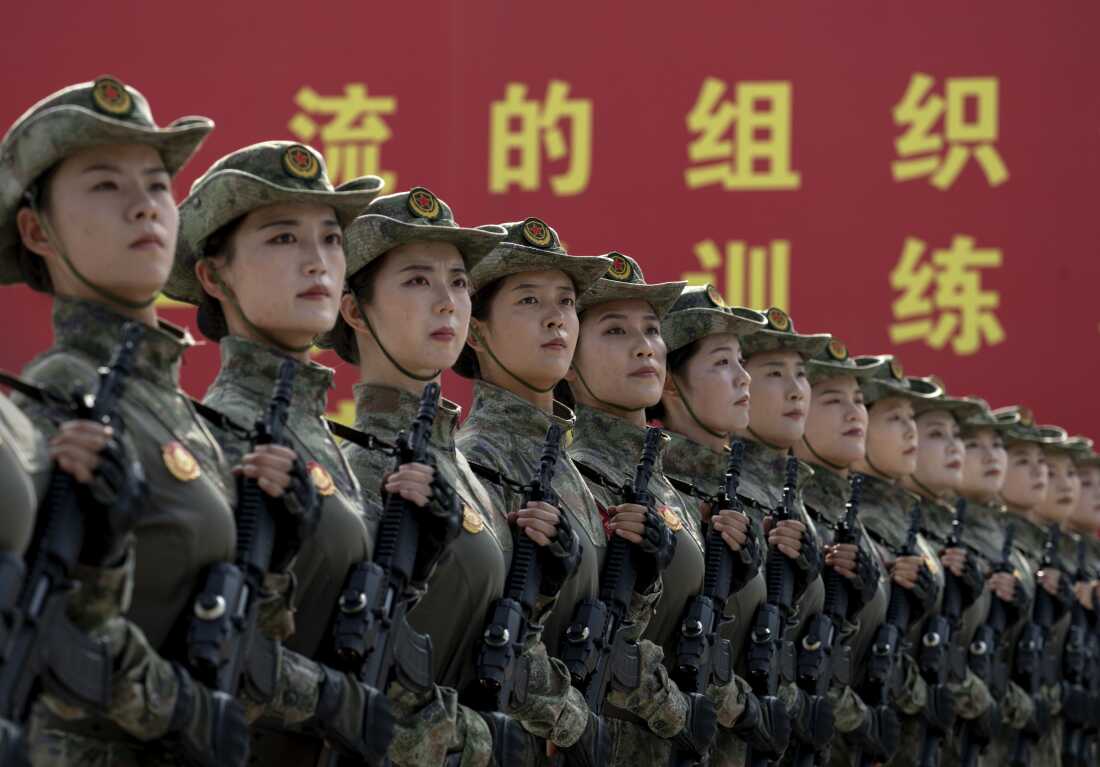
Female soldiers from the People’s Liberation Army stand in formation as they practice for an upcoming military parade to mark the 80th Anniversary of the end of World War II and Japan’s surrender, at a military base on August 20, 2025 in Beijing. Kevin Frayer/Getty Images/Getty Images AsiaPac hide caption
toggle caption
Kevin Frayer/Getty Images/Getty Images AsiaPac
As Imperial Japanese soldiers scour the streets, a group of civilians in the eastern Chinese city of Nanjing seek refuge in a small photography studio.
Developing photographs taken throughout the city, they uncover evidence of the horrific war crimes being committed by imperial invaders against their fellow Chinese citizens.
Set during 1937’s Nanjing Massacre, these scenes are from China’s latest hit film Dead to Rights. Released in July, the movie has caused a stir among some in China.
In Beijing, people stood outside the cinema waiting to watch the new box office hit, which has grossed over $400 million since its debut.
“We are Chinese, and we must remember history,” said Xiao Wu, a 25-year-old moviegoer after watching the film. “I also want to pay tribute to those predecessors and heroes who died in the War of Resistance against Japan.”
“We are where we are today because of the future that they built for us,” she added.
Dead to Rights is part of a series of new films that tell the story of China’s fight against Japanese occupation, also known as the “War of Resistance,” which ended with the defeat of Imperial Tokyo in 1945 at the end of World War II.

People visit the set where Dead to Rights, a Chinese historical drama about the 1937 Nanjing massacre during the Japanese occupation of Nanjing in the Second Sino-Japanese War, was filmed at the Shanghai Film Park in Shanghai on Aug. 27, 2025. HECTOR RETAMAL/AFP/Getty Images hide caption
toggle caption
HECTOR RETAMAL/AFP/Getty Images
Although World War II began in Europe in 1939, some historians say fighting in East Asia was ongoing as far back as 1931 when Japan invaded China’s northeastern region of Manchuria.
“China’s experience of World War II was devastating. It was the longest theater of war of any of the Allied powers,” said Rana Mitter, China historian at the Harvard Kennedy School.
At least 20 million people died in China during the years of war against Japan, although some historians put the number much higher.
With such a devastating impact, the War of Resistance against Japan has become a part of China’s national identity, says Mitter, who is also author of the book China’s Good War: How World War II Is Shaping a New Nationalism.
Beijing claims credit to show it’s a major power in the contemporary world order
A military parade marking World War II’s anniversary, the largest in years, will draw leaders from more than 20 countries on Wednesday. Russia’s Vladimir Putin and North Korea’s Kim Jong Un will both be in attendance, the first time both leaders will be seen together alongside China’s President Xi Jinping.
The event marks an opportunity for China’s leader to “gather together his coalition of the willing, and as many reputable leaders as he can,” said John Delury, senior fellow at The Asia Society. “It’s one other demonstration of a more Sinocentric world.”
But while Beijing’s communist leadership is keen to take credit for the role it played in ending Imperial Japan’s aggressions in East Asia, at the time of World War II, China’s internationally recognized government was not that of the Chinese Communist Party (CCP).

An officer runs back to his position after correcting soldiers from the People’s Liberation Army as they march in formation during a practice for an upcoming military parade to mark the 80th Anniversary of the end of World War II and Japan’s surrender, at a military base on August 20, 2025 in Beijing. Kevin Frayer/Getty Images/Getty Images AsiaPac hide caption
toggle caption
Kevin Frayer/Getty Images/Getty Images AsiaPac
Instead, the country was officially ruled until 1949 by Chiang Kai-shek and his Chinese Nationalist Party, or Kuomintang (KMT).
Although China’s Nationalists and Communists had been engaged in a civil war for control of the country, Japan’s invasion pushed both sides into an uneasy truce that lasted until Japan was defeated.
“Both the Chinese Communists and the Nationalist Party had a shared enemy,” Delury said. “It was that shared existential threat that allowed the two parties to form a united front.”
Despite the alliance, the Nationalists took on the brunt of the full-scale resistance against Japanese occupation from 1937 to 1945.
“Historians would say that overall, the majority of the wartime effort, including the set battles, were actually fought by China’s nationalists,” Mitter said.
Despite this, China’s state-led discourse centers on the achievements and actions of Communists in resisting the Japanese invasion during World War II.
“The CCP’s guerrilla warfare behind enemy lines and the Nationalists’ frontal battlefield operations worked in concert, forging an unbreakable wall of resistance through the Chinese people’s efforts in the War of Resistance Against Japanese Aggression,” wrote Qi Weiping, a former vice president of the Shanghai Association for the Study of CCP Party History, in a recent article. “This made a tremendous contribution to the ultimate victory in the global fight against fascism.”
As well as a grand display of military might, this week’s parade is, therefore, also an opportunity for Beijing’s ruling Communist Party to shape the historical narrative surrounding the end of the war and legitimize its existence domestically and on the international stage.
“Today, Communist China claims some of the achievements of Nationalist China as a means of showing that it is a major power in the contemporary world order,” Mitter said.
In Taiwan, clash of historical narratives — and interpretation of lessons of WWII
The distinction has stirred up disagreement in Taipei, across the contested Taiwan Strait, to which the KMT government fled after losing the Chinese Civil War to the Communists in 1949.
In northern Taipei, the Taiwanese capital, the island’s National Revolutionary Martyrs’ Shrine is a reminder of these clashing historical narratives.

Taiwan’s National Revolutionary Martyrs’ Shrine is a reminder of clashing historical narratives Jan Camenzind Broomby hide caption
toggle caption
Jan Camenzind Broomby
Cries and the stamping of military boots echo across the red and golden walls, as soldiers perform a changing of the guard ceremony in honor of fallen soldiers, while frescoes on the wall depict the Nationalist KMT military fighting both Japanese Imperial invaders as well as Chinese Communist soldiers.
More than 75 years after the KMT fled to Taiwan, the party has now become the main opposition in Taiwan’s democratic system. Its members still identify with the party’s history and espouse a more Chinese identity, despite not aligning themselves with the Communists from the mainland.
As Beijing gears up for the elaborate military parade, the KMT are keen to remind the international community that when Imperial Japan surrendered at the end of World War II, Tokyo surrendered to the KMT-run Republic of China government, rather than to the Chinese Communists of today.
“KMT is the only party to fight with a major role. We stood side by side with the United States, United Kingdom, with all the Allied forces,” said Assistant International Director of the KMT Chance Xu, standing in the party headquarters’ entrance.

Chance Xu says the KMT’s victory during WWII is still an important party of the party’s identity Jan Camenzind Broomby hide caption
toggle caption
Jan Camenzind Broomby
In the KMT office entrance lobby in central Taipei, proudly displayed documents, including the surrender treaty signed by the Japanese at the end of the war, tell the story of the party’s role in the defeat of Imperial Japan.
“We’re still very proud of it. It’s a very important element of our identity,” Xu said. But KMT party members say this is an identity that Taiwan’s current ruling party — the Democratic Progressive Party (DPP) — is ignoring.
Taiwan’s President Lai Ching-te, the party’s leader, has historically advocated for a more Taiwanese, as opposed to a Chinese, identity.
“The DPP has put forward a vision of Taiwan as somewhere much more autonomous, whose history is not really connected with the mainland,” said Harvard’s Mitter.
From 1895 until the end of World War II, Taiwan was a Japanese colony and was therefore already under Japan’s control at the time of World War II.

Imperial Japan surrendered at the end of World War II in 1945. Jan Camenzind Broomby hide caption
toggle caption
Jan Camenzind Broomby
China views President Lai as a campaigner for Taiwanese independence, a stance that flies in the face of Beijing’s belief that Taiwan should be under its control. While the island has never been controlled by China’s Communists, the CCP has vowed it will not renounce the use of force to take control of it.
Taiwan’s President Lai uses WWII anniversary to push back against Beijing
Taiwanese President Lai has used this year’s WWII anniversary to push back against Beijing’s increasing pressure on Taiwan and garner international support. He has also warned Taiwanese politicians not to attend Beijing’s Sept. 3 rally.
Unlike Beijing, Taipei will not stage major international ceremonies to mark the Japanese defeat this week. Instead, Lai spoke in May at an event marking the end of WWII in Europe.
“Taiwan and Europe are now facing the threat of a new authoritarian bloc,” the president said.
The speech represented the first time a Taiwanese President had celebrated Victory in Europe (VE) day, strengthening Taipei’s ties with Europe at a time when its relationship with Washington appeared more unstable.
“Lovers of freedom around the world, both individuals and nations, must now work together,” Lai said. “To make sure that aggressors have no opportunity to advance their ambitions.”

Taiwan’s President Lai reframes World War II as a battle of democracy versus authoritarianism. ChiangYing-ying/AP hide caption
toggle caption
ChiangYing-ying/AP
Lai’s opposition, the KMT, was not mentioned in his VE speech or in a subsequent Facebook post made on the anniversary of the end of fighting in Asia.
It also reframes and challenges Beijing’s narrative and makes the case that the real lesson of World War II is one about democracy vs. autocracy, said Mitter.
Lai Ching-te’s narrative therefore changes the view of China from a 20th century victor in the face of Imperial Japanese violence, to a 21st century perpetrator of aggression.
China rejects this view and has blasted Taipei for underplaying the role of Chinese Communists in defeating Imperial Japan.
“This is a grave blasphemy against all the loyal martyrs and heroes and a shameless betrayal of the entire Chinese nation,” said Zhu Fenglian, a spokesperson for China’s Taiwan Affairs Office, in response to Taipei’s framing.
As foreign dignitaries descend in Beijing this week, the conflicting narratives on both sides of the Taiwan Strait are a reminder that eight decades after Japan’s surrender, the guns may be silent, but the battle over the legacy of the war is far from over.












